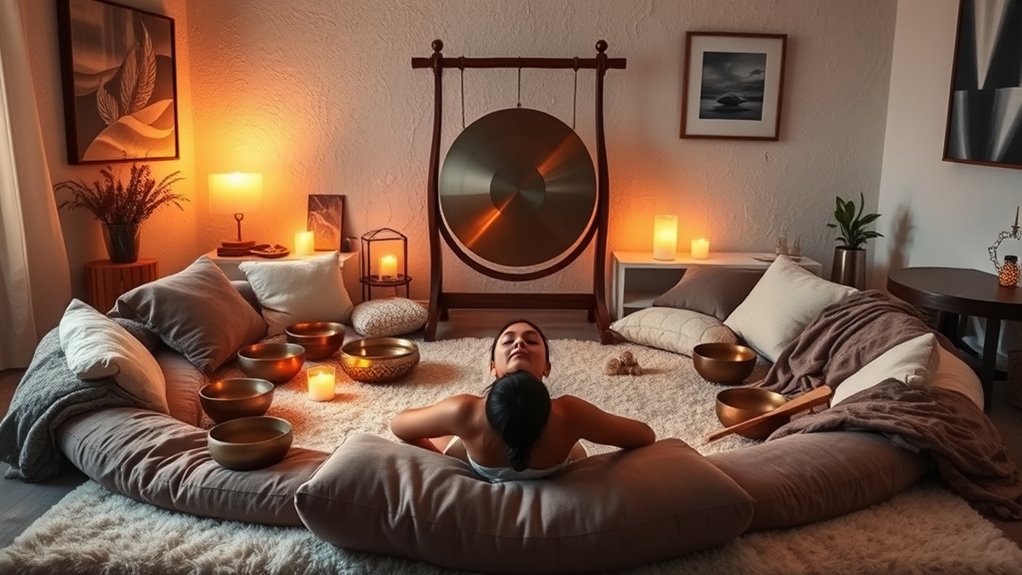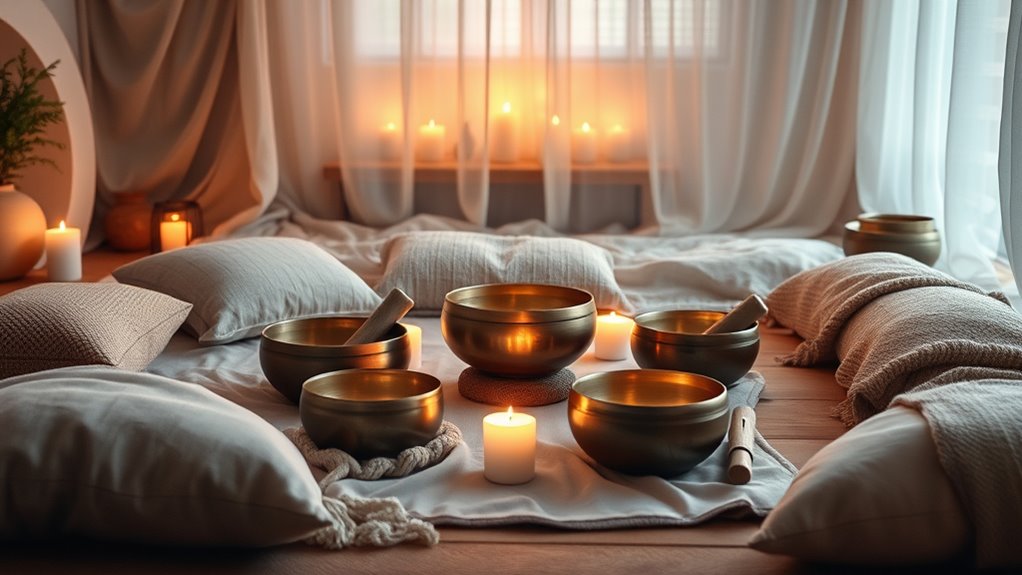A sound bath offers a relaxing experience that uses vibrations and soothing tones to help you achieve mental clarity, reduce stress, and restore energetic balance. You can host one at home by choosing a quiet, comfy space, dimming the lights, and using instruments like singing bowls or recordings. Incorporate deep breathing and set a peaceful intention to enhance your experience. Keep exploring to discover how to create an effective, calming environment and deepen your practice.
Key Takeaways
- A sound bath uses vibrations and tones to promote relaxation, mental clarity, and energetic balance through immersive soundscapes.
- Healing frequencies resonate with chakras, targeting stress points and supporting physical and emotional healing.
- Incorporate deep breathing, guided imagery, and meditation techniques to deepen relaxation during your home sound bath.
- Create a calm environment with quiet space, soft lighting, and instruments like singing bowls or recordings for an effective session.
- Play sounds gently, guide mindfulness, and reflect afterward to maximize benefits and ensure a meaningful experience at home.

A sound bath is a restorative experience that uses soothing vibrations and tones to promote relaxation and mental clarity. When you participate in a sound bath, you’re immersing yourself in a carefully curated soundscape that can profoundly influence your mental and physical state. Central to this experience are healing frequencies—specific sound vibrations believed to resonate with your body’s energy centers, or chakras, helping to restore balance and promote healing. These frequencies are intentionally chosen to target particular areas of stress or imbalance, making the sound bath not just calming but also potentially therapeutic.
A sound bath uses healing frequencies and soothing tones to promote relaxation and restore energetic balance.
To get the most from a sound bath, many practitioners incorporate various meditation techniques. These techniques serve as guides to deepen your experience, helping you stay present and focused amid the sounds. For example, deep breathing exercises can anchor your attention, allowing you to release tension with each exhale. Guided imagery or visualization might help you connect with the vibrations on a more personal level, fostering a sense of inner peace. When you combine meditation techniques with the healing frequencies of the sound bath, you amplify the calming effects, making it easier to access a state of mindfulness and relaxation.
If you’re thinking about hosting a sound bath at home, creating the right environment is key. Find a quiet, comfortable space where you won’t be disturbed. Dim the lights or use candles to foster a peaceful atmosphere. You can use singing bowls, tuning forks, or even recordings of healing frequencies if you don’t have physical instruments. As you prepare, consider setting an intention—whether it’s releasing stress, fostering creativity, or simply relaxing. Incorporate meditation techniques like focused breathing or body scans to help participants settle into the experience. Encourage everyone to sit or lie down comfortably, closing their eyes if they feel comfortable doing so.
During the session, play the sounds gently, allowing the vibrations to wash over everyone. Remind participants to breathe deeply and stay present, guiding them to tune into the subtle shifts in sound and how their bodies respond. The goal is to create a safe space where the vibrations can work their magic, allowing mental clutter to dissolve and physical tension to ease. Afterward, take a few moments for reflection, encouraging everyone to notice any changes in mood or body sensations. By understanding healing frequencies and integrating meditation techniques, you turn your home into a sanctuary for healing and relaxation, making the benefits of a sound bath accessible anytime you need a mental reset. Additionally, incorporating knowledge about sound frequencies can enhance your understanding of how specific vibrations influence your body’s energy centers.
Frequently Asked Questions
Can I Participate if I Have Hearing Aids?
If you have hearing aids, you can still participate in sound therapy, but it is crucial to check hearing aid compatibility. Many modern hearing aids are designed to work well with sound therapy sessions, enhancing your experience. To improve sound therapy accessibility, communicate with the facilitator beforehand. They can make adjustments or offer alternatives, ensuring you enjoy the benefits without discomfort or technical issues. Your participation is definitely possible with the right preparations.
What Safety Precautions Should I Consider?
When considering safety precautions for a sound bath, you should focus on soundproofing strategies to create a safe environment and determine an appropriate session duration. Guarantee the space is quiet enough to prevent disturbances and check if your hearing aids are compatible with the sound frequencies used. Always listen to your body, start with shorter sessions, and consult a professional if you have concerns, especially regarding hearing aids or sensitivity.
How Long Should a Home Sound Bath Last?
Imagine transforming your home into a sanctuary of tranquility—how long should this bliss last? Duration considerations suggest 30 to 60 minutes is ideal, giving enough time for deep relaxation without losing focus. Make sure your ambient setup is perfect, with calming light and comfortable space. Stick to this timeframe so your sound bath leaves everyone refreshed, relaxed, and enthusiastic for their next peaceful escape.
Are There Any Health Conditions That Prevent Participation?
You should check for medical restrictions before participating in a sound bath, especially if you have heart conditions, epilepsy, or pregnancy concerns. Allergy concerns are also important; those allergic to certain essential oils or incense used during sessions should avoid them. If you’re unsure, consult your healthcare provider to verify there are no risks. Listening to your body and respecting your limits helps you enjoy the benefits safely.
What’s the Best Time of Day to Host a Sound Bath?
Think of your day as a canvas, and choosing the right time for a sound bath as painting in perfect light. You should host it when your schedule allows for flexibility, ideally in the late afternoon or early evening when ambient lighting creates a calming atmosphere. This timing helps you unwind, making the experience more immersive. Select a moment free from distractions to fully embrace the soothing sounds.
Conclusion
Hosting a sound bath at home can be a transformative experience, helping you relax and reconnect with yourself. Did you know that 76% of people report feeling more centered and less stressed after just one session? By understanding the basics and creating a calming environment, you can enjoy these benefits anytime. So, gather your instruments, set the mood, and start your journey toward greater relaxation and mental clarity today.










